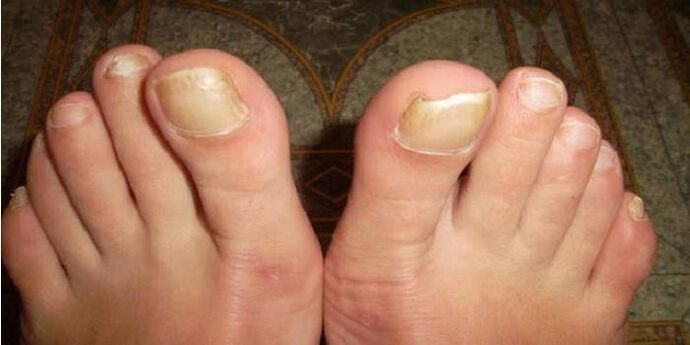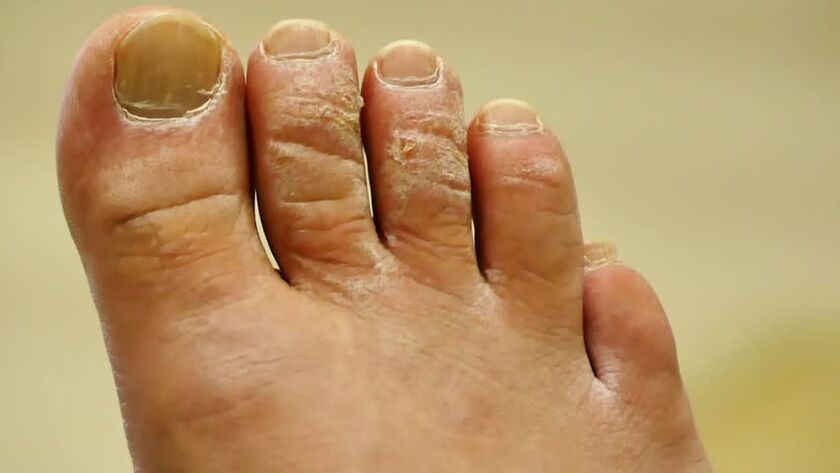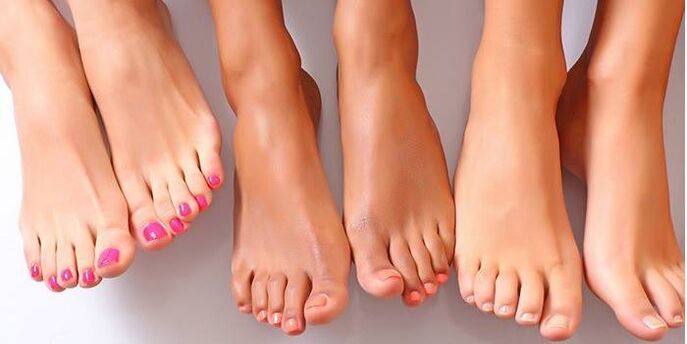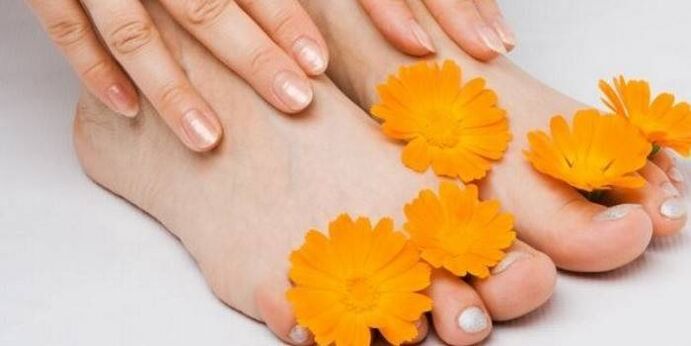Most fungal infections are difficult to treat. For this reason, the effectiveness of therapy against them is much greater at an early stage. To deal with the condition more quickly, you need to know how nail fungus starts. Often the person does not pay attention to the first symptoms, which is a big mistake. Progressing, the fungus not only significantly worsens the quality of life, but also leads to serious complications in the form of total loss of the nail plate and even sepsis.
what is foot fungus
In medicine, a fungus is understood as a group of diseases called mycoses. They rank second after purulent lesions of the epidermis - pyoderma. A pathogenic microorganism parasitizes a person's skin or nails, causing an infection. In the first case, the disease is called dermatomycosis and, in the second, onychomycosis. There are other types of fungal infections that are secreted depending on the pathogen. There are many types of fungi. They are divided into anthropophilic (affecting humans) and zooanthropophilic (observing in humans and animals).
The reasons
The main risk factor for getting a fungal infection is a weakened immune system. In that case, it is easier for the pathogen to enter the body. It is easy to get infected in public places, especially with high humidity and temperature, eg a swimming pool, gym, sauna, steam room. Among the risk factors for fungal diseases are also:
- flat foot;
- inadequate personal hygiene;
- circulatory disorders in the lower extremities;
- increased sweating;
- frequent trauma to the skin;
- obesity.
These are common causes of fungal infections. Common is the causative agent of the disease itself. Depending on the parasitic fungus, a person can develop the following types of infections:

Infection routes
The probability of infection is greater in children, as their thin skin makes them more susceptible to any microorganisms. Risk factors include a weakened immune system, problems with the nervous or endocrine system, the presence of chronic pathologies and an altered sweat composition. There are several ways to get a fungal infection. They fall into two main groups:
Foot fungus symptoms
A well-studied clinical picture of fungal infections helps to identify them at an early stage. Damage to the nail and soft tissue structures is visible at the site of injury to the naked eye. Common fungal symptoms are reflected in the following list:
- nail plate discoloration to light yellow at an early stage, then to yellow, brown, light green, even black;
- itchy sensation in the periungual area;
- unpleasant odor;
- hyperkeratosis, that is, thickening of the nail plate or its thinning;
- deformation of the free edge of the nail;
- peeling skin around the nail plate and in the interdigital spaces;
- calluses and calluses on the foot;
- nail fragility, its crumbling;
- redness of the skin around the nail plate.
Epidermophytosis and Trichophytosis
These forms of fungal infections occur in much the same way, which is why they have been combined into a group of diseases. They are called "foot mycoses". Depending on the form, the infection manifests itself in different symptoms. Often, a patient has several types of fungi combined at the same time. For this reason, the division of the fungus into shapes is conditional:
- scaly or scaly;
- dyshidrotic, which is accompanied by rupture of the sweat glands;
- intertrigious, in which diaper rash is seen on the skin;
- hypertrophic, atrophic or normotrophic onychomycosis.
Squamous form of foot fungus
The initial stage of leg fungus in this way is characterized by the defeat of just one foot. The infection passes to another only later. The disease can be recognized by the following signs:
- the appearance of a reddened area on the skin of the foot;
- in the future, this area starts to peel (affected areas may have a different area);
- some patients experience itching.
The difficulty in diagnosing and treating the scaly form is that many patients are not concerned about the symptoms. Therefore, they go to the doctor at an advanced stage. If the squamous form of the fungal infection persists for a long time, it can take on a dyshidrotic appearance. These two forms are intertwined, as they often cause each other to appear.

dyshidrotic form
This form is characterized by a course with changing periods of remission and relapse. Its first symptom is the appearance of blisters in the arch of the foot (more often than one) - where it does not come into contact with the ground when walking. Its size ranges from 2 to 8 mm. Gradually they begin to merge, merging into one big one. In addition, each blister is opened and a superficial lesion of the skin remains in its place - erosion.
In addition to the arch of the foot, its inner and outer lateral surfaces can become infected. At the site of ulceration of the vesicles, a large erosion remains, combined with diaper rash. The patient also complains of the following symptoms:
- pain and itching at the injury site;
- after erosion dries, it begins to peel, resulting in the development of a scaly shape;
- a bacterial infection gradually sets in, due to which the contents of the vesicles become cloudy, become purulent (in this case antibiotics must be taken);
- in the next phase, the skin on the foot becomes red, swells, the patient has severe pain and even fever.
Intertrigue form
Among all forms of trichophytosis and epidermophytosis, it is the most common. It develops alone or in the context of a type of squamous fungus. It is most often celebrated in summer. In winter there is a period of remission. The disease is chronic and long-lasting. The beginning of the process can be seen between 4 and 5 fingers, less often between 3 and 4. The first signs of an intertritigious form:
- cracks and macerations in the skin with a whitish border around it, which is formed by the exfoliating epidermis (superficial layer of the skin);
- itchy and burning sensation at the injury site;
- crying in the interdigital space;
- the appearance of erosion cracks at the site, accompanied by severe pain syndrome.
As the disease progresses, the skin sloughs off, diminishing its protective function. This increases the risk of developing streptococcal infection. It manifests as pustular inflammation, which is accompanied by swelling, redness and pain in the skin. In this context, an increase in body temperature is observed. The patient complains of a general deterioration in well-being.
Onychomycosis of the feet
This disease in 70-75% of cases affects 3 and 4 toes, less frequently - 1 and 5. Often, onychomycosis proceeds in the form of a normotrophic form, in which the nail color changes to yellow and its integrity is preserved . In the case of yeast infection, the infection develops in the context of other diseases. the nail turns yellow, brown or black.
It is possible to detect onychomycosis at an early stage through yellow spots and streaks on the nail plate. Pathological changes are first observed near its free edge. Depending on the form of onychomycosis, it manifests itself in the following symptoms:

Treatment of early-stage foot fungus
In the early stages of infection, topical preparations are used in the form of ointments, gels, adhesives, solutions, varnishes, sprays and liquids. They are effective because they act directly on the site of inflammation. For the interdigital spaces, a gel and suspension are more suitable, and an ointment for the skin of the heels. The early stage of nail fungus is treated with nail polish and antifungal solutions.
If the disease has reached an advanced stage, systemic medication is needed. They are used as pills and capsules. They destroy the infection from the inside out. In the early stage, the use of pills and capsules is irrational due to the greater number of side effects compared to local agents. In addition to medication, it is important to follow hygiene rules. This should be done as follows:
- wear closed slippers, do not walk around the house barefoot;
- treat shoes twice a day with special disinfectants;
- washing the patient's clothes separately from all other things;
- wash your feet daily and then treat them with antifungal agents;
- do wet cleaning in the room every day, ventilate;
- after bathing, rinse thoroughly with hot water;
- change socks daily;
- after recovery, discard the patient's socks, towels, shoes, washcloths, and other things.
To prevent possible relapses of the disease, it is necessary to strengthen the immune system. For this, immunomodulators and vitamins are prescribed to the patient. The basis of external and systemic therapy are antifungal drugs. When attaching a bacterial infection, antibacterial medications are used. Sometimes antihistamines are prescribed to relieve allergies.
Remedies for foot fungus
By knowing what fungus on nails looks like at an early stage, you may notice this much earlier. This will ensure faster recovery. The effectiveness of therapy also depends on the correct medication. There are many antifungal agents in the form of pills, ointments, gels. To use drugs correctly, you need to study their main characteristics:
Mechanism of action
Application method, effect
a course of treatment
Contraindications
naphthyfine hydrochloride
Destroys the causative agents of foot mycoses, some bacteria. It has an anti-inflammatory effect.
Rub the cream or solution onto clean skin twice a day.
2-4 weeks.
Pregnancy, lactation, age up to 18 years.
Natamycin
Effective against all foot mycosis pathogens.
Apply the suspension or cream several times a day to the affected skin.
Determined by a doctor.
Sensitivity to product constituents.
Clotrimazole
Many other antifungal agents have been synthesized based on this substance. Clotrimazole has a broad spectrum of action.
Apply to clean, dry skin 2-3 times a day.
1-4 weeks + 3 weeks after recovery.
Hypersensitivity to clotrimazole.
Econazole
It is effective against many ringworm pathogens, including mold and yeast-like fungi.
Apply cream, lotion, solution or aerosol 1-3 times daily on the skin of the feet.
2-4 weeks.
Pregnancy.
itraconazole
A wide range of activities against all fungal pathogens.
2 capsules twice a day - with onychomycosis; 0, 1-0, 2 g 2 times a day - with ringworm of the feet.
7 days, then a 3-week break - with onychomycosis;
1-2 weeks - with ringworm of the feet.
Pregnancy, lactation, simultaneous use with midozolam, nisoldipine, ergot alkaloids.
Sertaconazole
Fungistatic and fungicidal action against candidal fungi and trichophtons.
Apply a small amount of cream to the affected areas twice a day.
Up to 4 weeks.
Pregnancy, lactation, hypersensitivity, childhood.
terbinafine
Destroys candidiasis, trichophytes, emidermophytes pathogens.
0. 25 g 1-2 times a day.
6 weeks, with damage to the nail plates - 12 weeks.
Kidney and liver dysfunction, malignant neoplasms, pregnancy, lactation, vascular diseases of the legs.
Fluconazole
High activity against yeast fungi.
150 mg per week or 50 mg per day.
6 weeks.
Pregnancy, lactation, childhood.
griseofulvin
Fungistatic effect against pathogenic fungi.
16 mg per 1 kg of body weight daily for the first month of treatment;
more at the same dosage but every other day;
in the third month according to the second schedule, until healthy nails grow back.
Apply the ointment a maximum of 30 g per day.
For tablets - 3 months, for ointments - 3 weeks.
Liver and kidney dysfunction, decreased number of white blood cells, pregnancy, lactation, malignant tumors.

popular methods
Effective treatment, even in the early stages of a fungal infection, cannot be done without medication. They are the basis of therapy. Traditional methods are used only as an auxiliary method. Even though alternative medicine is relatively safe, you should consult your doctor before using it. He will give recommendations on the following alternative methods of treating a fungal infection:
























